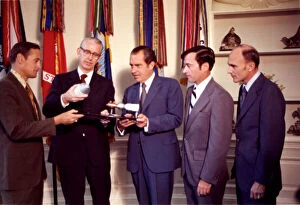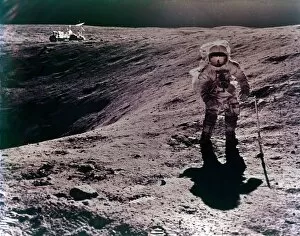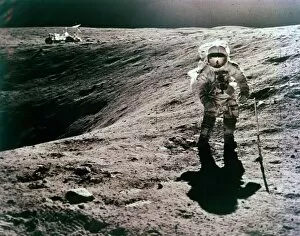Charles Moss Duke Collection
Charles Moss Duke, a renowned astronaut and part of the historic Apollo 16 mission in April 1972, played a crucial role in advancing our understanding of the Moon
For sale as Licensed Images
Choose your image, Select your licence and Download the media
Charles Moss Duke, a renowned astronaut and part of the historic Apollo 16 mission in April 1972, played a crucial role in advancing our understanding of the Moon. As captured by his lens, we witness Astronaut John Young gracefully navigating the lunar surface with awe-inspiring precision. Charles Duke's photographic talents also allowed us to marvel at the breathtaking sight of Orion from the Rover as it traversed this extraterrestrial landscape. The significance of their expedition was not lost on anyone, including President Nixon himself, who proudly posed alongside Dr. James Fletcher and the Apollo 16 astronauts. Their dedication and bravery were recognized as they embarked on this groundbreaking mission that would forever change our perception of space exploration. As their journey came to an end, Charles Duke immortalized the momentous occasion when Astronauts were recovered from the sea after completing their successful mission. The image serves as a testament to their triumph over adversity and showcases NASA's commitment to ensuring safe returns for its courageous explorers. Throughout his time on Apollo 16, Charles Duke continued capturing extraordinary moments such as Astronaut John Young's venturesome strides across the lunar surface at Descartes landing site. These photographs serve as timeless reminders of humanity's audacious spirit and unwavering determination to push beyond boundaries. With each click of his camera shutter, Charles Duke documented history in real-time – be it capturing Apollo 16 Lunar Module Orion resting serenely on the Moon or documenting every step taken during their meticulous exploration efforts. His contribution has left an indelible mark on our collective memory and continues inspiring future generations towards new frontiers yet unexplored. Charles Moss Duke cemented his place among legends through his remarkable photography skills that encapsulated both beauty and scientific discovery during one of mankind's most significant achievements - exploring another celestial body firsthand.











